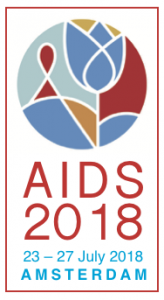22nd International AIDS Conference (AIDS 2018) – first reports
3 August 2018. Related: Conference reports, Conference index, World AIDS 22 Amsterdam 2018.
 23 – 27 July 2018, Amsterdam
23 – 27 July 2018, Amsterdam
The 22nd International AIDS Conference (AIDS 2018) was held this year from 23–27 July in Amsterdam.
Several thousand studies were presented as oral lectures or exhibited as posters over four days – so all reports touch on a minority of the research and activity – but much of the conference is also available online.
- Abstracts are online using a searchable database for the conference programme.
http://programme.aids2018.org - Clicking on a search result opens a separate window, either for the abstract or the session in which it was presented.
- Slides are available for most oral presentations and plenary lectures.
- Webcasts are available for many oral presentations (using the “video” link in the session window).
- Posters are available for many abstracts (using a PDF download link at the bottom of the abstract window).
- Oral abstracts are also available online and as a PDF supplement to JIAS.
https://onlinelibrary.wiley.com/doi/full/10.1002/jia2.25148
This was an important conference, with UK researchers involved in many interesting studies. These notably included having sites in both the PARTNER and GEMINI studies and for the RIVER study presenting results of the first randomised kick and kill cure-related study.
The meeting attracted high-profile speakers committed to HIV from fields of science, politics, entertainment, global health and human rights. All these talks and interviews are easy to watch on webcasts, especially for the opening and closing ceremonies or by searching the online programme.
This enables mainstream media coverage to highlight for a few days the fact that HIV is still an ongoing global crisis.
So for all the excitement about U=U and PrEP, these advances still only reach a minority of people who need them. Athough 22 million people are now on ART, 15 million are not, with many of these people currently untested. Some regions – including Eastern Europe and Central Asia (EECA) still have increasing HIV incidence and mortality. Viral load testing is still not routinely available to millions of people.
A useful discussion in the IAS pre-conference community cure workshop just before AIDS 2018 linked cure research to global HIV care. Both need a new simple home test for viral load, with a sensitivity threshold of perhaps 1000 copies/mL cut-off. This is essential for cure research if larger numbers of people stop ART as part of a cure strategy, as they will be vulnerable to unpredictable viral rebound, perhaps after weeks, months or years. This would also improve effectiveness of ART and give people the certainty to know if ART completely protects their partners.
Access to PrEP is improving in some settings, but globally is still struggling.
Reports included in this issue of HTB.

